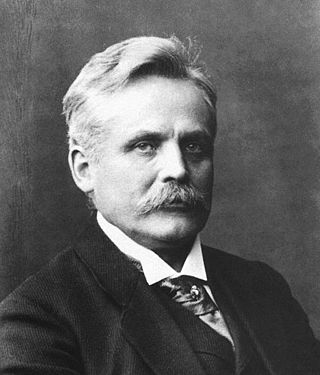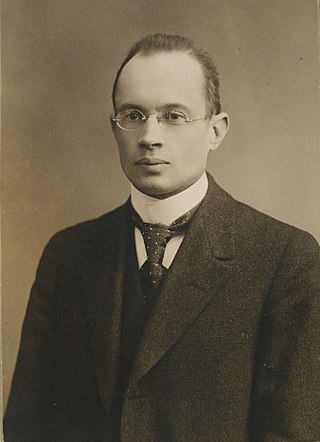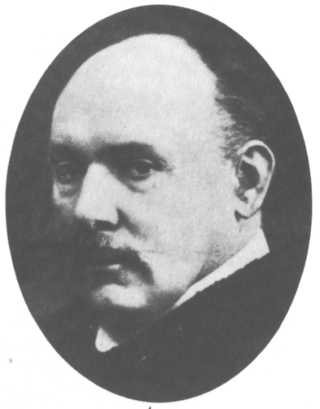
Vladimir Sergeyevitch Ignatowski, or Waldemar Sergius von Ignatowsky and similar names in other publications [1] ( born 8/20 March 1875 in Tbilisi, Georgia; died 30 January 1942 in Leningrad), was a Russian physicist. [2]

Vladimir Sergeyevitch Ignatowski, or Waldemar Sergius von Ignatowsky and similar names in other publications [1] ( born 8/20 March 1875 in Tbilisi, Georgia; died 30 January 1942 in Leningrad), was a Russian physicist. [2]
Ignatowski graduated in 1906 in Saint Petersburg. 1906-1908 he continued to study at the University of Giessen, with his dissertation in 1909. 1911-1914 he taught at the Higher Technical School in Berlin. Afterwards he worked for different institutions in the Soviet Union. Then he became a corresponding member of the Soviet Academy of Sciences.
Aleksandr Solzhenitsyn reported in his book The Gulag Archipelago, that Ignatowski was put under arrest by Soviet officials, who raised absurd allegations against him. It was claimed that Ignatowski was recruited by the German secret service in 1909, not to spy in the next war (World War I), but to spy in the "war after the next war" (World War II). So Ignatowski was executed in 1942 in Leningrad. [3] He was rehabilitated in 1955. [2]
Ignatowski wrote some papers on special relativity. [4] In 1910 he was the first to try to derive the Lorentz transformation by group theory only using the relativity principle, and without the postulate of the constancy of the speed of light (1910b, 1911b, 1911c, 1911h). Although he derived the correct transformation, the invariant limiting speed remained undefined. Ignatowski had to resort to length contraction of moving electrostatic fields in order to identify this limiting velocity with the velocity of light in vacuum. While some said that this approach was insufficient and the second postulate is still needed, others continued the attempts to derive special relativity without the light postulate (see Postulates of special relativity). [5] Ignatowski also investigated the status of rigid bodies within special relativity (1910a, 1911a). He concluded that velocities greater than the speed of light are possible, even though he showed that those are not signal velocities and therefore are not in conflict with relativity (1910b, 1911g). He also formulated a relativistic theory of hydrodynamics (1911f).
Ignatowski is also known for his work in the field of optics, whereby he founded the only optical-mechanical facility in the Soviet Union. [3] He is mentioned in Richard Adolf Zsigmondy's Nobel Lecture as the inventor of the concentric ball condenser for microscopes. [6]

Wilhelm Carl Werner Otto Fritz Franz Wien was a German physicist who, in 1893, used theories about heat and electromagnetism to deduce Wien's displacement law, which calculates the emission of a blackbody at any temperature from the emission at any one reference temperature.

Annalen der Physik is one of the oldest scientific journals on physics; it has been published since 1799. The journal publishes original, peer-reviewed papers on experimental, theoretical, applied, and mathematical physics and related areas. The editor-in-chief is Stefan Hildebrandt. Prior to 2008, its ISO 4 abbreviation was Ann. Phys. (Leipzig), after 2008 it became Ann. Phys. (Berl.).

Max Abraham was a German physicist known for his work on electromagnetism and his opposition to the theory of relativity.
Albert Einstein derived the theory of special relativity in 1905, from principle now called the postulates of special relativity. Einstein's formulation is said to only require two postulates, though his derivation implies a few more assumptions.

Friedrich Hasenöhrl was an Austrian physicist and professor of the University of Vienna. He postulated a relation between electromagnetic mass and energy, close to the modern mass–energy equivalence.
The history of special relativity consists of many theoretical results and empirical findings obtained by Albert A. Michelson, Hendrik Lorentz, Henri Poincaré and others. It culminated in the theory of special relativity proposed by Albert Einstein and subsequent work of Max Planck, Hermann Minkowski and others.

Gunnar Nordström was a Finnish theoretical physicist best remembered for his theory of gravitation, which was an early competitor of general relativity. Nordström is often designated by modern writers as The Einstein of Finland due to his novel work in similar fields with similar methods to Einstein.
The Ehrenfest paradox concerns the rotation of a "rigid" disc in the theory of relativity.
Born rigidity is a concept in special relativity. It is one answer to the question of what, in special relativity, corresponds to the rigid body of non-relativistic classical mechanics.

The Kaufmann–Bucherer–Neumann experiments measured the dependence of the inertial mass of an object on its velocity. The historical importance of this series of experiments performed by various physicists between 1901 and 1915 is due to the results being used to test the predictions of special relativity. The developing precision and data analysis of these experiments and the resulting influence on theoretical physics during those years is still a topic of active historical discussion, since the early experimental results at first contradicted Einstein's then newly published theory (1905), but later versions of this experiment confirmed it. For modern experiments of that kind, see Tests of relativistic energy and momentum, for general information see Tests of special relativity.
Gustav Herglotz was a German Bohemian physicist best known for his works on the theory of relativity and seismology.
Emil Georg Cohn, was a German physicist.
Jakob Johann Laub was a physicist from Austria-Hungary, who is best known for his work with Albert Einstein in the early period of special relativity.

Alfred Heinrich Bucherer was a German physicist, who is known for his experiments on relativistic mass. He also was the first who used the phrase "theory of relativity" for Einstein's theory of special relativity.
Paul Gerber was a German physics teacher. He studied in Berlin from 1872 to 1875. In 1877 he became a teacher at the Realgymnasium in Stargard in Pommern. Gerber is known for his controversial work on the speed of gravity and the perihelion shift of Mercury's orbit.
Friedrich Kottler was an Austrian theoretical physicist. He was a Privatdozent before he got a professorship in 1923 at the University of Vienna.
Criticism of the theory of relativity of Albert Einstein was mainly expressed in the early years after its publication in the early twentieth century, on scientific, pseudoscientific, philosophical, or ideological bases. Though some of these criticisms had the support of reputable scientists, Einstein's theory of relativity is now accepted by the scientific community.
Hermann Fritz Gustav Goos was a German physicist and astronomer.
Rudolf Weyrich was a German mathematician, physicist, and inventor.
Relativity
More